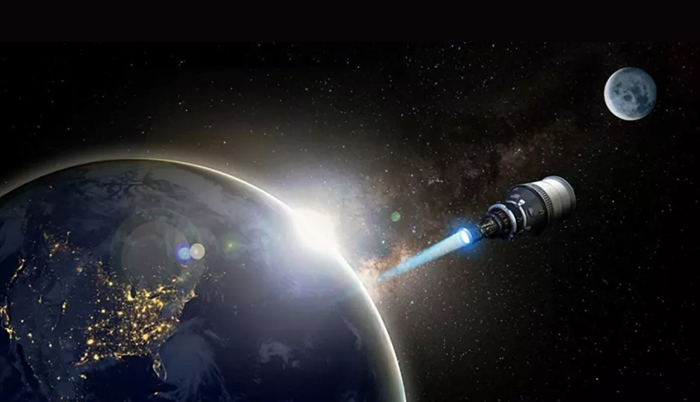![]() Home > Space & Science
Home > Space & Science
US Military Wants Nuclear Rocket Ideas For Missions Near The Moon

Artist's impression of a spacecraft powered by nuclear thermal propulsion. (Image credit: DARPA)
![]() May 11th, 2022 | 15:27 PM |
May 11th, 2022 | 15:27 PM | ![]() 405 views
405 views
UNITED STATES
The U.S. military hopes to see a flight demonstration in 2026.
The U.S. military is ready to take the next step in developing a nuclear rocket to help monitor Earth-moon space, an area it has deemed a high strategic priority.
The Defense Advanced Research Projects Agency (DARPA) announced May 4 that it's seeking proposals for the second and third phases of a project to design, develop and assemble a nuclear thermal rocket engine for an expected flight demonstration in Earth orbit by 2026.
"These propulsive capabilities will enable the United States to enhance its interests in space and to expand possibilities for NASA's long-duration human spaceflight missions," DARPA officials said in a statement.
The proposals will support DARPA's Demonstration Rocket for Agile Cislunar Operations (DRACO) program, which aims to develop a nuclear thermal propulsion (NTP) system for use in Earth-moon space. DRACO is part of the U.S. military's larger push to keep an eye on cislunar (Earth-moon) space as government and commercial activities increase in this sector in the coming decade.
NTP systems work by using fission reactors. The reactors heat hydrogen or other propellants to very high temperatures and then eject the superheated gas out of nozzles to create thrust.
Compared with electric propulsion systems, NTPs have a thrust-to-weight ratio about 10,000 times higher. And put against traditional chemical rockets, the propulsion efficiency (or specific impulse) of NTPs is roughly two to five times higher, DARPA officials wrote in a description of the DRACO program.
Phase 1 for Draco included awards in April 2021 for General Atomics, Blue Origin and Lockheed Martin. The phase was scheduled to last 18 months across two independent tracks.
Track A, for General Atomics, included the preliminary design of a nuclear thermal propulsion reactor, along with a propulsion subsystem. Track B, pursued by Blue Origin and Lockheed Martin independently, aimed to create an "operational system spacecraft concept" to meet future mission objectives, including a demonstration system.
In September 2020, DARPA also awarded a $14 million task order for DRACO to Gryphon Technologies, a company in Washington, D.C. that provides engineering and technical solutions to national security organizations.
NASA is also interested in nuclear thermal propulsion, for its potential to get missions to Mars in half the time than the current six to nine months possible with current propulsion systems. NASA's fiscal 2023 budget request, not yet approved by Congress, includes $15 million to support nuclear propulsion.
The space agency is collaborating on the DRACO project "using non-reimbursable engagement with industry participants where technology investments have common interest to both organizations," NASA officials wrote in the $26 billion budget request for fiscal year 2023, which was released in March.
In the last fiscal year, NASA collaborated on flight demonstration projects "with subject matter expertise, fuel testing and turbine machinery design," the agency wrote of its DRACO work.
Notably, for fiscal year 2022, the U.S. House of Representatives allocated $110 million focusing on nuclear thermal propulsion, "rejecting the Biden administration's proposal to refocus NASA's efforts on developing a nuclear reactor that could power crewed bases on the moon and eventually Mars", according to the American Institute for Physics.
Source:
courtesy of SPACE
by Elizabeth Howell
If you have any stories or news that you would like to share with the global online community, please feel free to share it with us by contacting us directly at [email protected]